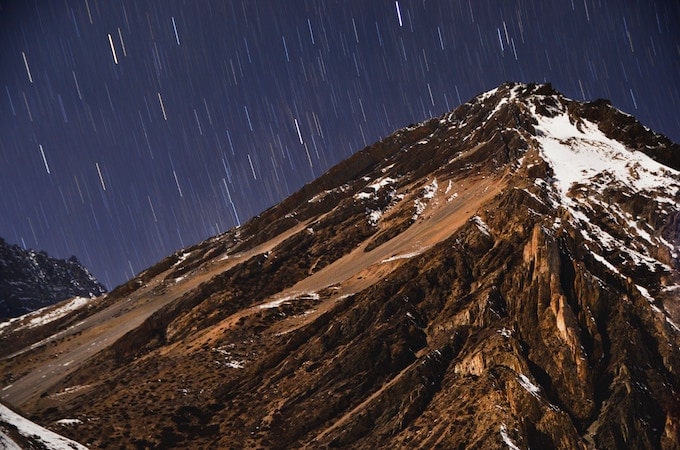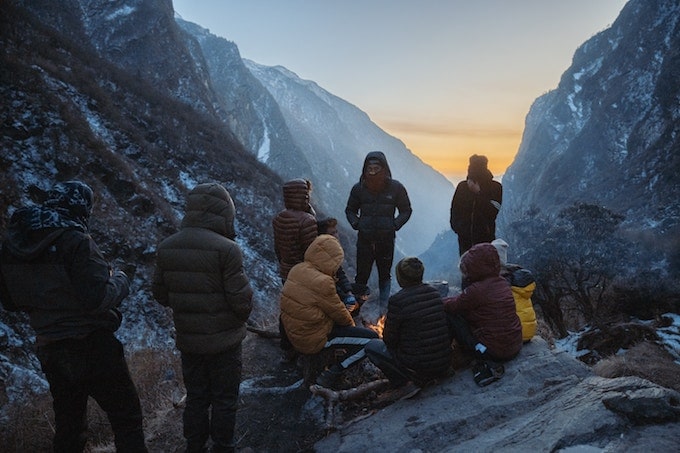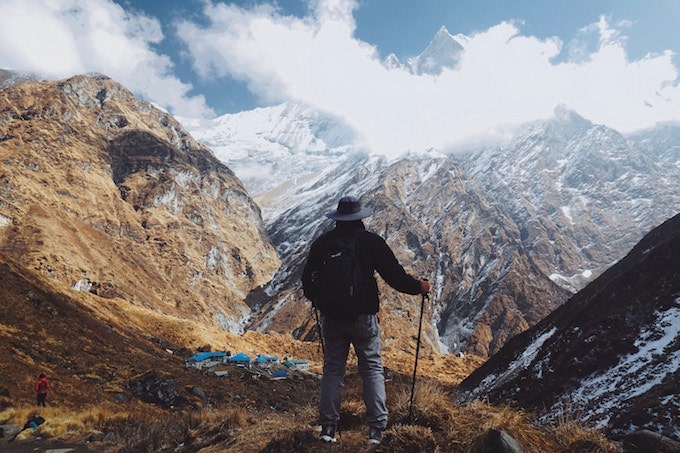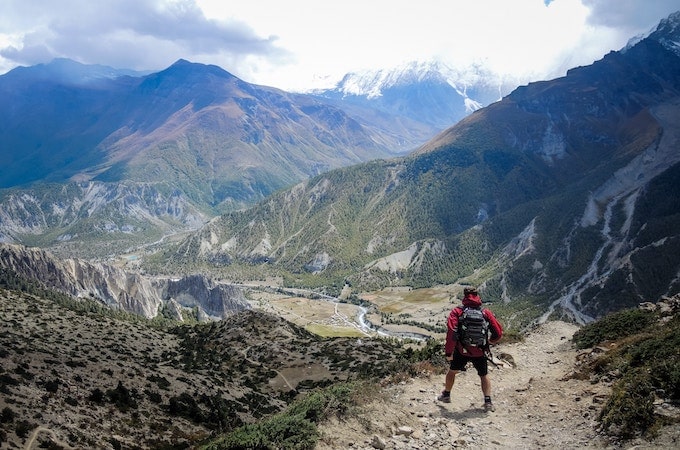If you do a quick Google search for the best treks in the world, there’s a high likelihood you’ll find the Annapurna Circuit near the top of every list.
This world famous trek takes you through the Annapurna mountain range of central Nepal, covering a total distance of roughly 230 kilometres, depending on where vehicles are used. You’ll pass through river valleys, breathe in the mountain air, and sleep in the coziest tea houses the remote wilderness has to offer.
Typically taking anywhere from 15 to 25 days, this trek is not for the faint of heart. It’s a difficult trek, reaching altitudes of 5415 metres above sea level and days that can be over eight hours long. That being said, it’s a challenge that offers beautiful and rewarding payoffs for those who successfully complete the feat.
If you’re thinking of packing up your hiking boots and setting foot in the Annapurna Circuit, here’s everything you need to know, from what to pack to what time of year you should start your trek.
What to expect from the Annapurna Circuit
As mentioned earlier, the Annapurna Circuit is one of the most popular treks in the world and has been for decades. Ask any generation of avid hiker and they’ll probably refer to the circuit as the holy grail for hikers. But what makes this trek so special? Why is it worth the trip? What can you expect?

1. It’s different every day
You’ll start in the jungle, then find yourself weaving through narrow canyons. Next, you’re in dense pine tree forests, before even getting a glimpse at the stunning peaks of the mountains. It’s almost every landscape you could possibly imagine, and experiencing all of them is a wonder in its own right.
2. It’s one big party
Each year, more than 40,000 people pack their bags and hike the Annapurna Circuit, meaning you’re going to make a lot of friends out on the trails. Whether it’s a young couple from Brazil or a group of retirees from Spain, this trail is filled with people from all different walks of life, all ready to befriend you.
3. The food is amazing
Traditional Nepalese food is beyond words. Dal
4. It’s filled with life
The Annapurna Circuit is trail bursting with life. Unlike many other treks, this trail is still a fully functioning trade route that supplies remote villages with everything from spices to salt
5. The weather is bizarre
There’s a high chance you’ll experience every type of weather humanly possible on the Annapurna Circuit. From hot sunny days that feel like the tropics, to below-freezing temperatures and squalls of snow, you’re definitely going to experience a little bit of everything.

Guide to the Annapurna Circuit: How to book the trek
When to go
While the trail is open for travel at any time of the year, there are a few months you may want to rule out based on difficult weather conditions:
- Cold Season: December – February
- Hot Season: May – June
- Monsoon Season: July – September
- Peak Season: October – November
- Shoulder Season: March – April
Most hikers opt to trek in the month of October. This is right after monsoon
Hiking permits
In order to hike the Annapurna Circuit, you’ll need the required two permits:
- TIMS: Trekkers Information Management System is a must for anyone looking to trek in Nepal. It was implemented by the Nepal Tourism Board and the trekking Agencies Association of Nepal to ensure all hikers are safe in their travels.
- ANCAP: The Annapurna Conservation Area Entry Permit allows hikers to enter the protected area of the Annapurna region, allowing tourism and travel to remain sustainable, economical, and safe.
Hiking the Annapurna Circuit solo vs. on tour
Most hikers looking to tackle the Annapurna Circuit opt to join a tour. While the circuit can be done solo, this requires some serious planning, including where you’ll stay, what you’ll eat, how you’ll prepare food, etc. Opting to hike with a tour company ensures all of the complicated aspects of the trip are covered, allowing you to arrive and hike without worry.
Booking lead time
As with most tours, it’s recommended that you book your tour as soon as you know when you’d like to hike. Because the trail is so popular, many hiking companies book months in advance. It is possible to find last-minute accommodations, but it’s not a risk you’ll likely want to take.

Annapurna Circuit packing list
For this trip, you’re going to want to pack a little bit of everything, as the weather changes to vastly from day one to day 15. That includes a raincoat, a bathing suit, hiking shoes, flip-flops, sunscreen, bug spray, a baseball cap, sunglasses, and mittens. All the must-haves for any hiking trip, plus a few thoughtful essentials:
- Daypack (because you’ll be handing over most of your luggage to your tour company, make sure you’ve got a great day pack to carry your daily essentials)
- Lightweight camera (it’s a good idea to bring your lightest camera on this trip, as any bulky will cause you a headache)
- Layers of socks (yes, believe it or not, you’re going to want different types of socks, from thin ankle socks, to warm cotton socks)
- Portable solar charger (there will be few chances for you to charge your devices, so bring a back-up that’s solar powered)
- Duct tape (seriously, a roll of duct tape can solve almost any hiking problem, from a broken flip-flop to a ripped hiking bag)

Guide to the Annapurna Circuit: Trail details
Number of days
Depending on which option of the trek you opt for, the length can vary from as little as 13 days to as long as a month. It really depends on what your hiking style is and how much time you have. Typically, it takes 18 days to complete the circuit.
Trails Specs
- Difficulty: Medium to Difficult
- Maximum altitude: 5415m
- Total distance: 230k
Annapurna Circuit weather
Regardless of when you trek, the weather is going to be all over the place. You’ll experience rain, snow, and everything in between. So be prepared for anything. The two peak seasons weather typically looks like:
Peak Season: October – November
Ranges from 15 degrees to 5 degrees Celsius, night temperatures remain above freezing. Naturally, the higher you go, the colder it gets.
Shoulder Season: March – April
Ranges from 10 degrees to 0 degrees Celsius, night temperatures sitting aright around freezing. Mornings and nights in the higher regions often fall below freezing.

A typical Annapurna Circuit itinerary summary
Day 1 and 2: Kathmandu
Arrive in Kathmandu and spend the next two days acclimatizing and exploring this amazing city. You’ll have time to discover the beautiful Hindu shrine of Pashupatinath and the Kathmandu Durbar Squire. If you need to buy any last minute trekking gear, the time is now.
Day 3: Drive from Kathmandu to Bhulbhule
Wake up early in the morning and enjoy a traditional breakfast before leaving the hotel shortly after 7 am. You’ll drive along the Kathmandu-Pokhara Highway to Dumre before arriving at your lodge in Bhulbhule.
Day 4: Bhulbhule to Chamje
Start the morning off early, hiking for 6 hours to Chamje. The trail is flat for the first few hours but then becomes more difficult as it cuts into the sheer cliff-face over 300 metres above the riverbed.
Day 5: Chamje to Dharapani
This day’s hike is difficult, descending towards the river, crossing a suspension bridge, and climbing an extremely steep path to Sattale. The trail becomes a bit more manageable after this difficult start.
Day 6: Dharapani to Chame
The hike begins through a narrow field from the village, then veers left as Annapurna II becomes visible right in front of you. You’ll pass through a Bhote village with prayer flags fluttering in the breeze and finish with a flat walk towards Chame.
Day 7: Chame to Pisang
The mountain disappears as you climb up the valley, passing through an apple orchard and continuing through a fir and pine forest. The path then becomes quite steep-sided leading out of the forest to a beautiful vista outside of Pisang.
Day 8: Pisang to Manang
Today you’ll hike a steep ridge that provides amazing views of the Manang Valley and Tilicho peak. The day will continue with five hours of somewhat challenging hiking, ending with your first views of the stunning Himalayas.
Day 9: Acclimatization in Manang
Give your lungs a breather and rest your legs with a rest day in Manang. Hang out in the town and get used to the higher altitudes, or visit Ganagapurna Glacier Lake to make your day a memorable one.
Day 10: Manang to Yak Kharka
On this day, you’ll enjoy panoramic views for the entire hike. You may notice that you feel a bit fatigued or short of breath as you head higher up and into less oxygen.
Day 11: Yak Kharka to Thorung Phedi
After a gradual climb up a ridge, you’ll descend towards the headwaters of the Marsyangdi and cross over a wooden bridge. You’ll then follow a narrow trail up the mountain slope and finally descend towards Thorung Phedi.
Day 12: Thorung Phedi to Muktinath
Day 12 is an early morning crossing the Thorung La. The trail is steep immediately upon leaving camp, but the very well-defined and easy for walking. The views of snow-covered mountains are dramatic and make for a pleasant day of hiking.
Day 13: Muktinath to Kagbeni
On this day you’ll have the chance to visit the famous temple of Muktinath before trekking down the stunning Kali Gandaki Gorge. You’ll then pass through the primitive Tibetan village of Kagbeni where you’ll be able to relax and spend the night.
Day 14: Kagbeni to Jomsom
Today you’ll walk the flat path along the banks of Kali Gandaki Gorge and take in the views as you wander. You’re in the same geological and climatic zone as Tibet as you head towards the town of Jomsom.
Day 15: Jomsom to Ghasa
This hike starts with a steep descent through the forests of Ghasa – the last Thakali village and the most southern limit to Tibetan Buddhism. This area is known for its bountiful bird watching, so keep your eyes peeled and your camera ready.
Day 16: Ghasa to Tatopani
After breakfast, you’ll start the steep descent to Rupse Waterfall, one of the most beautiful sites on your trek. The trail then passes through various settlements as you head towards Tatopani. Get your bathing suit ready, because today you’ll have the chance to take a bath in the natural hot springs.
Day 17: Tatopani to Ghorepani
Today you’ll get to experience some of the unique wildlife this region has to offer. As you pass through rhododendron forests, you may be able to spot some monkeys passing through the trees or hear various birds singing above your head.
Day 18: Ghorepani to Poon Hill to Hile
Start your day enjoying the breathtaking sunrise over the Himalayas from Poon Hill. From here you’ll be able to see endless mountains for what seems like forever. From here you’ll hike up and down through more forests, passing through a few villages towards Hile.
Day 19: Hile to Nayapul, drive to Pokhara
As the last day of your Annapurna journey, the day’s hike is quite easy. You’ll walk a slight descent following the Bhurung Stream, all the way to Nayapul. Here your vehicle will be waiting to take you to Pokhara for the night.
Day 20 and 21: Drive Pokhara to Kathmandu
The next morning the car will drive you from Pokhara to Kathmandu. You’ll have the day for some much-deserved relaxation before you board your flight back home the following day.
Do you have experience with the Annapurna Circuit? Tell us all about it in the comments!

